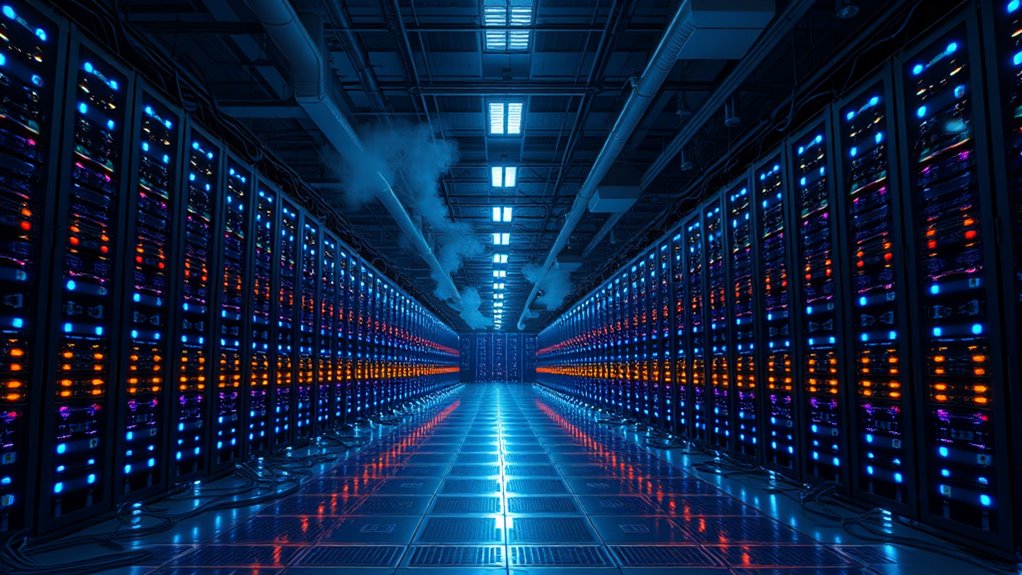AI data centers are rapidly increasing their energy use, with projections reaching up to 580 TWh annually by 2028. This surge could strain existing power grids, especially as new facilities demand several gigawatts of energy. Localized stress and infrastructure upgrades may become necessary to prevent outages. If these trends continue, the U.S. might face a significant power crunch. Keep exploring to understand how this growth impacts the nation’s energy future.
Key Takeaways
- AI data center energy demand in the US could increase over 30 times by 2035, risking grid stress.
- Future AI campuses may require up to 5 GW, significantly straining existing energy infrastructure.
- Growing data center loads are already causing local grid challenges and necessitating utility upgrades.
- Despite efficiency improvements, AI workloads continue to drive overall energy consumption upward.
- The surge in AI data centers could push US electricity use to 12% by 2028, risking power shortages.

As artificial intelligence continues to expand, the power demands of data centers supporting these technologies are soaring in the United States. By 2035, US AI data center energy consumption could increase over 30 times, reaching roughly 123 gigawatts—a dramatic jump from just 4 gigawatts in 2024. Current hyperscaler data centers in the US typically use less than 500 MW each, but upcoming projects may demand 2,000 MW or more. Some future campuses could span 50,000 acres and consume as much as 5 GW, highlighting the scale of expected growth. In 2023, data centers already used about 176 TWh, accounting for roughly 4.4% of US electricity consumption, a share that’s likely to rise with AI’s expansion. Projections suggest that by 2028, data center electricity demand might reach between 325 and 580 TWh, representing roughly 6.7% to 12% of total US energy use. Increasing capacity of data centers underscores the urgent need for grid modernization and sustainable energy solutions to support this growth.
AI data centers in the US may consume up to 580 TWh annually by 2028, representing over 12% of national energy use.
This concentrated growth in specific regions creates local grid stress, especially where data centers cluster. Power demand surges could strain existing infrastructure, forcing regional utilities to plan and upgrade quickly. States like Texas have already introduced programs such as ERCOT’s Controllable Load Resource, which enables rapid connection of large loads, emphasizing the need for grid flexibility. To manage future demands, grid operators may need to incentivize data centers to participate in demand response programs or develop on-site generation. Regulatory reforms could also streamline interconnections and support flexible load management, alleviating the burden on local grids.
Energy consumption trends reveal that servers and GPUs—key components of AI workloads—saw their energy use grow from 2 TWh in 2017 to 40 TWh in 2023. While efficiency improvements in power usage effectiveness and computational methods have helped, they can’t fully offset the rapid scaling of AI workloads. Many tech giants report PUE data mainly for owned data centers, leaving gaps in understanding the full efficiency picture across leased facilities. Despite these gains, total data center energy use is expected to continue rising.
Looking ahead, US data centers could consume about 88 TWh annually by 2030, equivalent to the electricity needs of some large states. AI data centers alone might account for up to 32% of the nation’s total electricity production by 2026, raising serious concerns about infrastructure resilience and sustainability. This surge in demand complicates efforts to reduce carbon emissions and meet climate goals. Accurate forecasts and strategic planning are essential to ensure the grid can handle this growth without risking power shortages or environmental setbacks.
Frequently Asked Questions
How Much Additional Energy Do AI Data Centers Consume Annually?
AI data centers consume roughly an additional 70 to 80 terawatt-hours of electricity annually, based on current growth trends. As AI models grow larger and retraining becomes more frequent, this consumption is expected to nearly triple by 2028. You should be aware that this rising demand puts significant stress on the power grid, increasing the need for infrastructure upgrades and cleaner energy solutions to meet future demands sustainably.
What Regions Are Most Impacted by Increased AI Data Center Power Use?
You’ll notice Northern Virginia, Phoenix, and Dallas bear the brunt of increased AI data center power use. As these regions attract hyperscale facilities, their power grids face intense pressure, with demands soaring into gigawatts. The rapid growth, driven by infrastructure and utility partnerships, strains local resources. Meanwhile, regions like Silicon Valley and Chicago, with their advanced connectivity, also experience heightened stress, risking power shortages without strategic upgrades.
Are There Renewable Energy Solutions for AI Data Centers?
Yes, there are renewable energy solutions for AI data centers. You can depend on solar panels installed on-site or at remote sunny locations, and purchase wind power from onshore or offshore farms. Combining these sources helps balance generation variability. Additionally, using advanced energy storage like heat batteries, and locating data centers in regions rich in renewables, guarantees continuous, clean power that reduces dependence on fossil fuels and minimizes environmental impact.
How Do AI Data Centers Compare in Energy Efficiency to Traditional Data Centers?
They say “you are what you measure,” and when it comes to energy efficiency, AI data centers often lag behind traditional ones in overall power use. While AI centers use advanced cooling and renewable sources, their heavy computational loads and volatile demand make them less efficient per task. You need to weigh the benefits of AI’s capabilities against its higher energy consumption, which can strain power grids and increase environmental impact.
What Policies Are in Place to Regulate AI Data Center Energy Consumption?
You’ll find that policies now prioritize rapid development and energy management of AI data centers through federal permits, financial incentives, and streamlined environmental reviews. While federal agencies encourage grid integration, local and state laws still regulate energy use and environmental impacts. You may face hurdles like community opposition or jurisdiction overlaps, but federal efforts aim to boost energy efficiency and supply, ensuring data centers operate sustainably amidst growing demand.
Conclusion
As you watch the rise of AI data centers, remember they’re like mighty rivers feeding a future landscape. Their flow promises innovation but risks flooding our power grid with endless demand. If you ignore this current, the lights may flicker and fade, symbolizing a world caught between progress and exhaustion. Stay aware and act now—because the choices you make today shape whether our energy future is a thriving garden or a desert of darkness.











